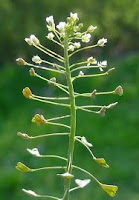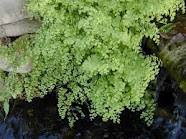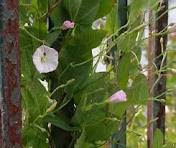Shepherd’s purse can be found all over the world, in Europe , West Africa and Asia , and is naturalized in many other countries. It is a member of the Bassicaceae or Cruciferae family so is related to the cabbage, mustard, brussel sprout and broccoli. Capsella means capsule and refers to the seed pods of this plant while bursa means purse and pastoris of rural people. If you have traveled to rural parts of Portugal Greece
 It has been used to stem internal and external bleeding since time immemorial and the European agency has recognized it as being safe to treat internal and external bleeding, in infusions and liquid extracts mainly because it has been in use for longer than thirty years to treat such problems and the use has been widely documented. Some research has been done which appears to show that it can help angina pectoris sufferers and to regulate blood pressure and some of its constituents have been studied in other plants, but the studies have not been sufficient for the cautious medical establishment to accept their use as yet.
It has been used to stem internal and external bleeding since time immemorial and the European agency has recognized it as being safe to treat internal and external bleeding, in infusions and liquid extracts mainly because it has been in use for longer than thirty years to treat such problems and the use has been widely documented. Some research has been done which appears to show that it can help angina pectoris sufferers and to regulate blood pressure and some of its constituents have been studied in other plants, but the studies have not been sufficient for the cautious medical establishment to accept their use as yet. The young leaves of the plant if gathered in spring before it flowers can be used in salads or cooked as a green vegetable as you would cook spinach. They have been used as cabbage substitutes, but reportedly, when the leaves get older they become tougher and have a rather more peppery flavour, rather like watercress. The root can apparently be a substitute for ginger root if you happen not to have any to hand.
The young leaves of the plant if gathered in spring before it flowers can be used in salads or cooked as a green vegetable as you would cook spinach. They have been used as cabbage substitutes, but reportedly, when the leaves get older they become tougher and have a rather more peppery flavour, rather like watercress. The root can apparently be a substitute for ginger root if you happen not to have any to hand. The leaves are rich in vitamins C and A in the form of beta-carotenes and they also contain vitamin K along with the B-complex vitamins, thiamin, riboflavin and niacin. As for flavonoids they contain quercetin and kaempferol among others and the flavonoid glycosides in the plant include rutin, diosmin and hesperitin. Amino acids include proline, tyramine and ornithine. The minerals it contains are potassium, manganese, copper, iron, calcium and phosphorous. It is particularly rich in iron, calcium and vitamin C so useful for anaemia. Saponins and tannins are present as well, and the off-putting odour you smell when you pick the plant may be because of sinigrin which is a mustard oil glycoside. The volatile oil’s major constituent is camphor, and perhaps it should be noted that the plant also contains vanillic and fumaric acids.
 According to the
According to the When combined with other herbs shepherd’s purse has been used for cardio-vascular diseases, but its main claim to medicinal fame is its ability to staunch the blood from external wounds, (Culpeper in the 17th century said that it was particularly good for head wounds when used in an ointment) and for internal haemorrhages, blood in the urine and for helping stem the blood flow after childbirth and during heavy menstruation as it acts on the muscles of the uterus. The tisane can be used for these purposes and although the dried aerial parts of the plant are used, the fresh flowering herb is much more effective as it tends to lose its potency after being dried. It is said that it will work for up to a year, but if you have access to the fresh herb – and after all it is very common – use this.
 To make the decoction you need to chop up the above ground parts of the plant including the flowers; 1 ounce of the plant needs 12 fluid ounces of water which should be boiled, then simmered to reduce it to ½ pint of liquid. Strain it and drink cold. In
To make the decoction you need to chop up the above ground parts of the plant including the flowers; 1 ounce of the plant needs 12 fluid ounces of water which should be boiled, then simmered to reduce it to ½ pint of liquid. Strain it and drink cold. In The whole plant has also been used to alleviate the pains associated with rheumatism in poultices.
The seed pods can be ground and added to soups and stews rather like pepper, and the seeds may be eaten cooked or raw.
 The seeds are believed to be effective against mosquito larvae and can be used in the water they are hatched in so the shepherd’s purse seeds could in future help to prevent outbreaks of malaria and dengue, as it is said that they have insecticidal properties. Good news for
The seeds are believed to be effective against mosquito larvae and can be used in the water they are hatched in so the shepherd’s purse seeds could in future help to prevent outbreaks of malaria and dengue, as it is said that they have insecticidal properties. Good news for 














































